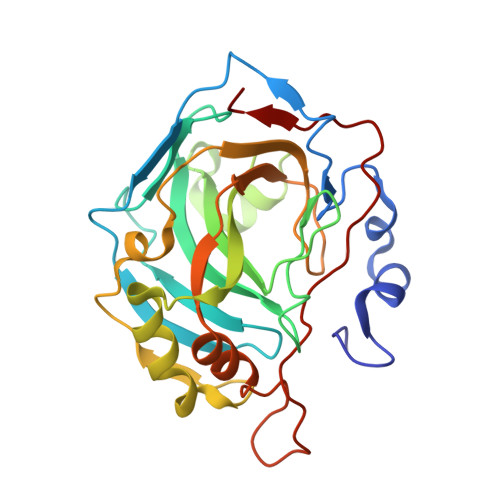Interactions between Hofmeister Anions and the Binding Pocket of a Protein.
Fox, J.M., Kang, K., Sherman, W., Heroux, A., Sastry, G.M., Baghbanzadeh, M., Lockett, M.R., Whitesides, G.M.(2015) J Am Chem Soc 137: 3859-3866
- PubMed: 25738615
- DOI: https://doi.org/10.1021/jacs.5b00187
- Primary Citation of Related Structures:
4YGJ, 4YGK, 4YGL, 4YGN - PubMed Abstract:
This paper uses the binding pocket of human carbonic anhydrase II (HCAII, EC 4.2.1.1) as a tool to examine the properties of Hofmeister anions that determine (i) where, and how strongly, they associate with concavities on the surfaces of proteins and (ii) how, upon binding, they alter the structure of water within those concavities. Results from X-ray crystallography and isothermal titration calorimetry show that most anions associate with the binding pocket of HCAII by forming inner-sphere ion pairs with the Zn(2+) cofactor. In these ion pairs, the free energy of anion-Zn(2+) association is inversely proportional to the free energetic cost of anion dehydration; this relationship is consistent with the mechanism of ion pair formation suggested by the "law of matching water affinities". Iodide and bromide anions also associate with a hydrophobic declivity in the wall of the binding pocket. Molecular dynamics simulations suggest that anions, upon associating with Zn(2+), trigger rearrangements of water that extend up to 8 ? away from their surfaces. These findings expand the range of interactions previously thought to occur between ions and proteins by suggesting that (i) weakly hydrated anions can bind complementarily shaped hydrophobic declivities, and that (ii) ion-induced rearrangements of water within protein concavities can (in contrast with similar rearrangements in bulk water) extend well beyond the first hydration shells of the ions that trigger them. This study paints a picture of Hofmeister anions as a set of structurally varied ligands that differ in size, shape, and affinity for water and, thus, in their ability to bind to¡ªand to alter the charge and hydration structure of¡ªpolar, nonpolar, and topographically complex concavities on the surfaces of proteins.
Organizational Affiliation:
?Department of Chemistry and Chemical Biology, Harvard University, 12 Oxford Street, Cambridge, Massachusetts 02138, United States.
















